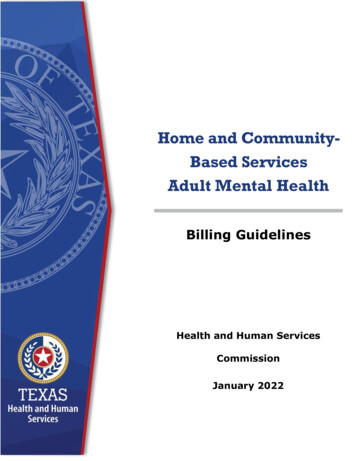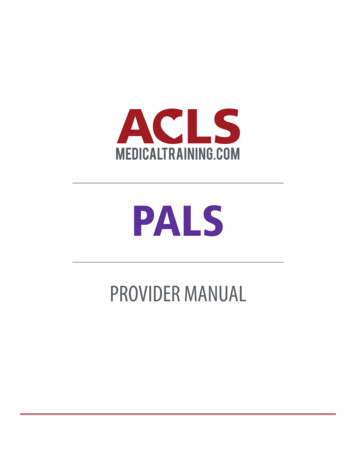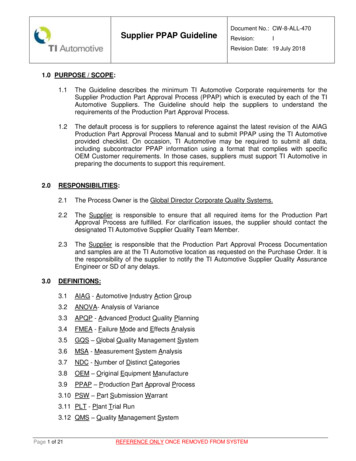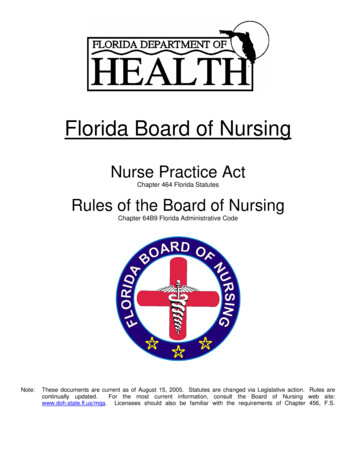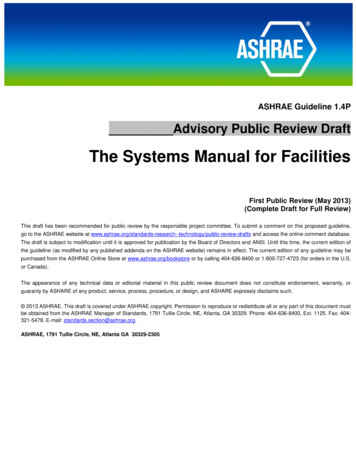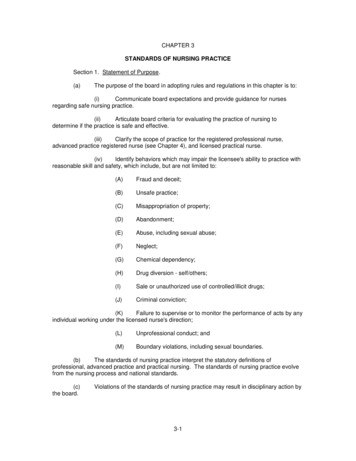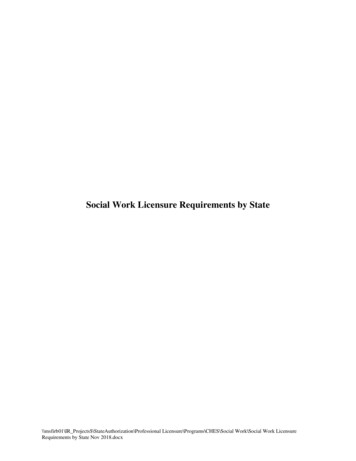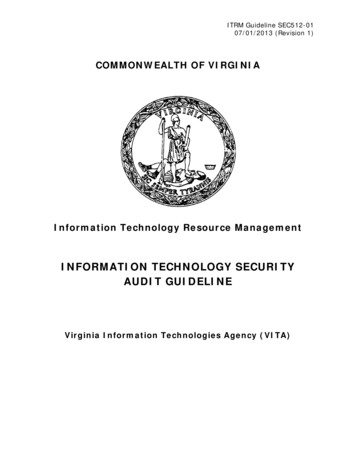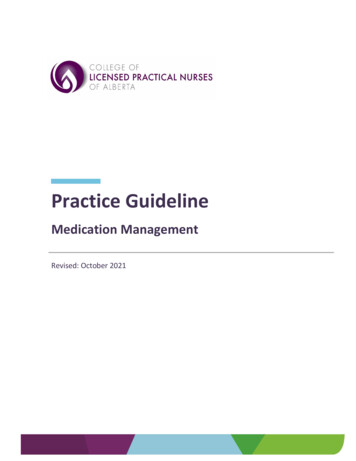
Transcription
Practice GuidelineMedication ManagementRevised: October 2021
This document is linked to legislation:Health Professions ActLicensed Practical Nurses Profession RegulationThis document is linked to other documents that direct expectations of professional behaviour or requirementsfor practice:Standards of PracticeStandards of Practice on Restricted Activities and Advanced PracticeCode of EthicsStandards of Practice on Boundary ViolationsProfessional Responsibility and AccountabilityPractice and Education Requirements for Restricted Activities and Advanced PracticeThis document is linked to related supportive documents:REVISIONS and UPDATESUpdated January 2019 (Medical Cannabis)Updated February 2020Updated October 2021 (MAiD)Practice Guideline: The legislative mandate of the College of Licensed Practical Nurses of Alberta (CLPNA) is toserve and protect the public by ensuring its members deliver safe, competent, and ethical nursing care. A PracticeGuideline is an evidence informed document designed to assist membership with making decisions aboutappropriate practices. These documents support professional judgment and permit flexibility in practice.Approval DateRevision DateApproverJune 2018October 2021Council College of Licensed Practical Nurses of Alberta, 2021
Table of ContentsIntroduction . 6The LPN Role in Medication Management . 6Authorization for Medication Administration . 7Federal and Provincial Legislation . 7Medical Assistance in Dying (MAiD) . 8Hemodialysis . 9LPN Profession Specific Documents. 9Employer Requirements . 9Individual Competence . 9Medication Orders . 10Authorized Prescriber . 10Components of a Complete Medication Order . 10Abbreviations . 10Orders transmitted via technology . 11Verbal and Telephone Orders . 11Intermediaries . 12Order Sets . 13Protocols . 14Protocols for Schedule 1 Drugs . 14Emergency Situations. 14Medication Rights & Checks . 14Right Reason . 15Right Patient. 15Right Medication . 15Right Dose . 15Right Route . 16Administration by Other Delivery Devices . 16Right Time and Frequency . 16Right to Refuse (and Right to Know) . 16Right Documentation (and Right Evaluation) . 16Checks . 17Check 1: . 17
Check 2: . 17Check 3: . 17High-Alert Medications & Independent Double Checks . 17Medication Reconciliation . 17Steps of Medication Reconciliation . 18Medication Preparation . 18Medication Preparation from Ward Stock. 19Mixing Medications. 19Pre-Pouring Medication . 19Pass and Bridge Medications . 19Sample Medication . 20Range Doses . 20Sliding Scales . 21Pro Re Nata (PRN) Orders . 21Administration and Management of Controlled Drugs and Substances . 22Administration and Documentation of Narcotics . 22Naloxone . 22Off-Label Use of Medication . 22Medication Administration for the Purpose of Research . 23Medication Administration for Aesthetic Purposes . 24Administration of Cannabis for Medical Purposes . 24Administration of Complementary and Alternative Therapies . 25Immunization and Vaccine Administration. 25Allergy Testing and Desensitizing Injections (Immunotherapy) . 26Evaluating Patient Outcomes. 26Documentation . 27Medication Administration Record (MAR) . 27Storage, Disposal, and Transportation of Medication . 27Disposal of Controlled Drugs and Substances . 28Over-the-Counter Medications . 28Patient’s Own Medication . 28Self-Administration . 28Acute Care and Continuing Care Facilities . 29Home Care and Supportive Living Settings . 29Supervision and Assignment of Components of Medication Administration to Health Care Aides . 294
Assigning Assistance with PRN Medications . 30Assigning Assistance with Insulin Administration . 30Supervising a Practical Nurse Student Assigned to Perform a Restricted Activity . 31Co-Signing for Students. 31Medication Safety . 31Safety and Infection Prevention and Control . 31Hazardous Medications . 32Strategies to Reduce Medication Errors and Adverse Events . 32Reporting Adverse Events, Medication Errors, or Near Misses . 33Conclusion . 33Glossary . 34References . 375
IntroductionThe College of Licensed Practical Nurses of Alberta (CLPNA) has a mandate to ensure Licensed PracticalNurse (LPN) services in Alberta are provided in a manner that protects and serves the public throughexcellence in practical nursing. The purpose of this Medication Management Guideline is to provideguidance to LPNs by enhancing the understanding of the LPN role and expected practices in medicationmanagement. Guidelines are not intended to be exhaustive but to provide guidance in making informeddecisions.The Canadian Patient Safety Institute defines medication management as patient-centered careoptimizing safe, effective, and appropriate drug therapy provided in collaboration with patients andtheir health care team(s).1 This guideline refers to the assessment, planning, preparation,implementation, administration, evaluation, and documentation required in the management ofmedication.This guideline is based on federal and provincial legislation, the LPN profession Standards of Practice,Code of Ethics, and the Competency Profile for LPNs.2 This version of the document reflects updatesbased on the amendments to the Licensed Practical Nurses Profession Regulation effective February 1,2020. It is also informed by Accreditation Canada’s Medication Management Standards, guidelinesprovided by the Institute for Safe Medication Practices, the Canadian Patient Safety Institute, and thework of other nurse regulators across Canada.3The LPN Role in Medication ManagementMedication administration must be performed in accordance with legislation, regulatory standards,policy documents, and employer requirements. The LPN may administer medication4 under thefollowing conditions: The LPN must have the education, knowledge, and competence to accept and transcribemedication orders according to best practice;1Canadian Patient Safety Institute (CPSI), “Medication Management,” ic/Pages/Medication-Management.aspx2Canadian Council for Practical Nurse Regulators (CCPNR), Code of Ethics for Licensed Practical Nurses in Canada(2013) c CCPNR CLPNA Code of Ethics.pdf; CCPNR,Standards of Practice of Licensed Practical Nurses in Canada (2013), http://www.clpna.com/wpcontent/uploads/2013/02/doc CCPNR CLPNA Standards of Practice.pdf; College of Licensed Practical Nurses ofAlberta (CLPNA), Competency Profile for Licensed Practical Nurses, on Canada, Medication management standards (April 2016).4All bolded text is defined in the Glossary located at the end of this guideline.6
The LPN must have the education, knowledge, and competence to safely prepare, initiate,administer, monitor, titrate, and discontinue medications;The LPN must adhere to the core rights and checks of medication administration to ensurepatient safety; andThe LPN’s decision to administer medications must always include the patient's individualneeds determined through health assessment, the LPN's competence, and the availability ofsupports in the practice environment to ensure safe medication administration.Authorization for Medication AdministrationFederal and Provincial LegislationDrugs in Canada are controlled at a federal level by the Food and Drug Act, the Controlled Drugs andSubstances Act and the regulations associated with those Acts – including the Natural Health ProductsRegulations.In Canada drugs are categorized into three schedules, or four categories:1. Schedule 1 drugs require a prescription as a condition of sale.2. Schedule 2 drugs are available without a prescription but must be obtained from a pharmacist.3. Schedule 3 drugs are available without a prescription from the self-selection area of apharmacy.4. Unscheduled drugs are not listed in a National or Provincial schedule and may be sold from anyretail outlet.5The National Association of Pharmacy Regulatory Authorities maintains an online database of theNational Drug Schedules available at http://napra.ca/national-drug-schedules. Alberta’s provincial drugschedules are generally aligned with the National Drug Schedules. To review the list of exceptions visitthe Alberta College of Pharmacists’ website at https://pharmacists.ab.ca/drug-schedules. Health Canadamaintains a database with information on licensed natural health products available at x-eng.jsp.The LPN’s authorization to administer medication in Alberta is primarily governed by two pieces ofprovincial legislation, the Government Organization Act and the Licensed Practical Nurses ProfessionRegulation (LPN Regulation).Schedule 7.1 of the Government Organization Act contains a list of high risk health service activities,known as restricted activities. These activities may only be performed by regulated health professionalswho have been specifically authorized in their profession’s regulation to do so. This requirement ensures5Alberta College of Pharmacists (ACP), Understanding Alberta’s Drug Schedules es/UnderstandingABDrugSchedules.pdf.7
that only professions with the necessary competencies can perform the restricted activities defined inthe Government Organization Act. Although medication administration is not a specific restrictedactivity, the route or way a medication is administered may be a restricted activity. The GovernmentOrganization Act does not place restrictions on the administration of medications by non-invasiveroutes, which include oral, topical, or inhalation.The LPN Regulation permits LPNs to perform the restricted activity of administering anything by aninvasive procedure on body tissue below the dermis for the purpose of administering injections or forstarting a peripheral intravenous line. Therefore, under the LPN Regulation the LPN may prepare,initiate, monitor, titrate, and discontinue the delivery of medications via infusion or injection thatincludes, but is not limited to, the following routes: intravenous, intradermal, intramuscular, orsubcutaneous.The LPN Regulation permits LPNs to perform the restricted activity of administering medication via acentral venous line or administering parenteral nutrition if the LPN obtains advanced authorization fromthe Registrar. Practice and education requirements for administering medications via a central venousline and administering parenteral nutrition can be found in the following documents: Standards ofPractice on Restricted Activities and Advanced Practice (Standards 1, 2, 17, and 18) and the CLPNA Policyon Practice and Education Requirements for Restricted Activities and Advanced Practice.NOTE: Please refer to the Competency Profile for LPNs regarding the LPN scope of practice specific tomedication administration and management.Medical Assistance in Dying (MAiD)In June 2016 the federal government enacted legislation that allows for the provision of medicalassistance in dying under certain circumstances. In Canada, the Criminal Code allows nurses to assist aphysician or nurse practitioner (NP) in the provision of MAiD as per the direction of their respectiveregulatory bodies. A nurse who is assisting a physician or NP must also be under the direction of thephysician or NP, otherwise they cannot assist. Only a physician or NP can assess eligibility for MAiD andonly the physician or NP can administer the substance(s) that causes death.In 2021 there were amendments to MAiD legislation such as the eligibility criterion for MAiD. However,the role of the LPN has not changed.The CLPNA recommends that: any LPN who has been asked to participate in MAiD contact the Practice Team at CLPNA ifthey have related questions; and they can also find guidance from the provincial MAiD Care Coordination Service in Alberta atwww.ahs.ca/MAID.8
HemodialysisIn accordance with the LPN Regulation, hemodialysis is a restricted activity requiring advancedauthorization. In order for LPNs to provide hemodialysis nursing they must complete educationapproved by the Registrar and receive advanced authorization by the Registrar. For more informationplease see the Standards of Practice on Restricted Activities and Advanced Practice (Standards 1, 2, and16) and the CLPNA Policy on Practice and Education Requirements for Restricted Activities and AdvancedPractice.LPN Profession Specific DocumentsIn all aspects of medication administration the LPN is expected to follow the Standards of Practice, Codeof Ethics, Standards of Practice on Restricted Activities and Advanced Practice, and the most currentCompetency Profile for LPNs, where competencies specific to medication administration are outlined.Employer RequirementsWhile the CLPNA has the regulatory authority to define the scope of practice for LPNs in Alberta,employer organizations define the role of the LPN specific to the practice environment(s). This may varydepending on the specific care requirements, care delivery model, and staff mix in the practice area.LPNs must work within the role articulated by employer job description and any related employerrequirements.With respect to medication administration, legislation does not specify what medications can beadministered by which provider. This allows flexibility for employers to determine what medications areappropriate for certain providers to administer based on patient needs, provider competencies, and theresources available in that specific care environment. LPNs must follow employer requirements aroundthe medications considered appropriate for them to administer within a given care environment. Incertain areas of practice, employers may require LPNs to obtain site-specific education beforeperforming certain activities within their facility.Individual CompetenceNursing competence represents the integrated knowledge, skills, behaviours, attitudes, critical thinking,inquiry, and clinical judgments required to provide safe, competent, and ethical nursing care. LPNs havethe responsibility and accountability to ensure they hold individual competence in their nursing practice.The expected competencies of an LPN for medication management can be found in the currentCompetency Profile for LPNs. LPN competencies specifically related to medication management includeunderstanding of the pharmacokinetics and pharmacodynamics associated with medicationadministration; relative assessments; safe handling, preparation and administration of medications;monitoring and managing any adverse effect or reaction; teaching patients; and evaluating,documenting, and communicating the patient response to medication.9
The core importance with the administration of any medication is to ensure it is appropriate for thatpatient. This means that the LPN is knowledgeable about the medication, safe recommended dosage,appropriate route, indications, contraindications, side effects, interactions, precautions, onset, duration,excretion, related-lab values, appropriate evaluation, and documentation.6Medication OrdersAuthorized PrescriberLPNs require an order from an authorized prescriber before administering medication to a patient.Authorized prescribers may include physicians, medical residents, nurse practitioners, pharmacists,midwives, and dietitians.7 LPNs are responsible for knowing and staying up to date on who is anauthorized prescriber. In order to act on a medication order appropriately, LPNs may need to discussprescribing authority with the prescriber as some healthcare professionals may have limited prescribingauthority.Components of a Complete Medication OrderAcceptable medication orders are clear, complete, current, legible, and clinically relevant. The LPNshould clarify any missing components and unclear directions with the authorized prescriber as soon aspossible and before taking any further action. A complete medication order includes the: patient’s full name; date prescribed; medication name, strength, and dosage; route; dose frequency (i.e., how often the medication is to be administered); reason the medication is prescribed; and signature of the authorized prescriber.8If the order is unclear, incomplete, or there is any question of accuracy, the LPN must contact theauthorized prescriber for clarification prior to administration.AbbreviationsAbbreviations and acronyms are a short-hand form of communication often used in medicalprescriptions, orders, and documentation (e.g., mg for milligrams). Although abbreviations andacronyms can seem like a quick shortcut, the use of abbreviations is also one of the most commoncauses of medication errors. 9 The Institute for Safe Medication Practices has published a list ofDangerous Abbreviations, Symbols and Dose Designations. Accreditation Canada recommends that6Patricia Potter et al., eds., Canadian Fundamentals of Nursing (Toronto, ON: Mosby/Elsevier Canada, 2015), 663.ACP, “Understanding the Prescriber Lists,” rescriber-lists.8Accreditation Canada, Medication Management, 43.9Health Quality Council of Alberta (HQCA), Abbreviations (2017) http://abbreviations.hqca.ca/learn-more.710
employers provide a list of abbreviations, symbols, and dose designations that are not to be used intheir workplace.10 LPNs should familiarize themselves with the dangerous abbreviations and symbolsand must ensure their workplace policy regarding abbreviations and symbols is followed by clarifyingany unapproved abbreviations used in an order before proceeding.If a medication order contains an unapproved abbreviation or symbol, the LPN has a responsibility toclarify the order before continuing with the medication administration process.Orders transmitted via technologyThe CLPNA supports the appropriate use of technology to communicate a medication order.All components of a complete medication order must be met regardless of the format. All sharedinformation must be handled in a manner that upholds the privacy and confidentiality of patientinformation. Additionally, medication orders need to be received in a manner that allows the personreceiving the order to verify the authorized prescriber who is providing the order. A medication orderreceived via fax or electronic transmission must be transcribed in the appropriate manner.The LPN must follow employer requirements as to when the receipt of faxed or electronically transmitted orders for medications areacceptable; and how faxed or electronically transmitted orders are to be transcribed.The LPN must ensure accurate transcription and recording of all order instructions in a timely mannerupon patient admission, end of service, transfer to another level of care, or, as otherwise required.The LPN must validate the accuracy, clarity, and completeness of the transcription of the order beforeassessing the patient and administering the medication.Verbal and Telephone OrdersAlthough authorized prescribers are expected to provide written orders (or enter the order into theelectronic health record) whenever possible, in some situations an authorized prescriber may need toinitiate or change medications before they are able to provide the written order in-person. Verbal ortelephone orders can be more error-prone than written orders due to the increased potential ofmiscommunication or misunderstanding.11 Verbal or telephone orders should be limited to emergent orurgent situations.A medication order received verbally or by telephone must be transcribed in the appropriate mannerand verified by the authorized prescriber as soon as possible within the time frame defined by employer10Accreditation Canada, Medication Management, 43.Institute for Safe Medication Practices (ISMP), “Despite Technology, Verbal Orders Persist, Read Back is notWidespread, and Errors Continue,” ISMP Medication Safety Alert, May 18, owarticle.aspx?id 1167.1111
requirements. If an order has not been verified within this time frame, the LPN must not proceed withfurther medication administration until this has been addressed.In addition to the standard components of a complete medication order, a verbal and telephonemedication order must also include: the date and time the order was transcribed; a notation that this was a verbal or telephone order; the LPN’s signature and credentials; and identification of the authorized prescriber (name, practice ID, and any additional employerrequirements).12The LPN is required to confirm the accuracy of the order by reading it back in its entirety to theauthorized prescriber. It is important for the LPN to ensure that accurate transcription of allinstructions occurs in a timely manner.The LPN is to follow employer requirements regarding: Whether verbal and telephone orders for medications can be accepted and in whichsituations; Which care providers may accept them; and How verbal and telephone orders are to be transcribed.IntermediariesAn intermediary is someone who communicates a verbal prescription between an authorized prescriberand a pharmacist. For example, an LPN may be asked to be an intermediary in a homecare setting. Useof an intermediary is
Updated January 2019 (Medical Cannabis) Updated February 2020 Updated October 2021 (MAiD) Practice Guideline: The legislative mandate of the College of Licensed Practical Nurses of Alberta (CLPNA) is to serve and protect the public by ensuring its members deliver safe, competent, and ethical nursing care. A Practice

